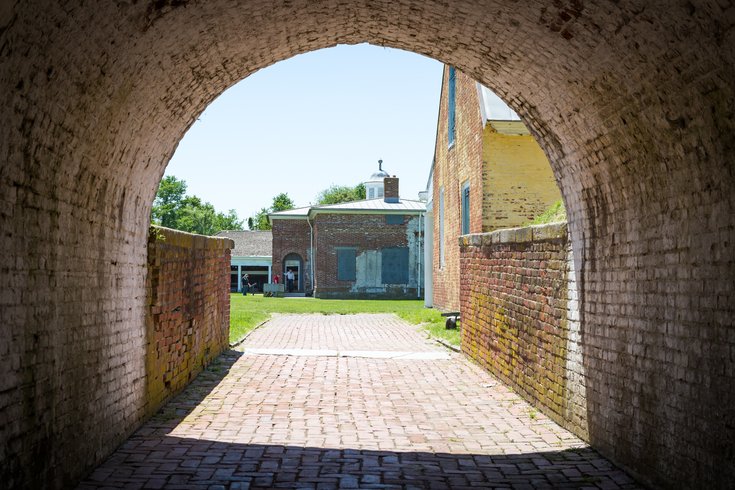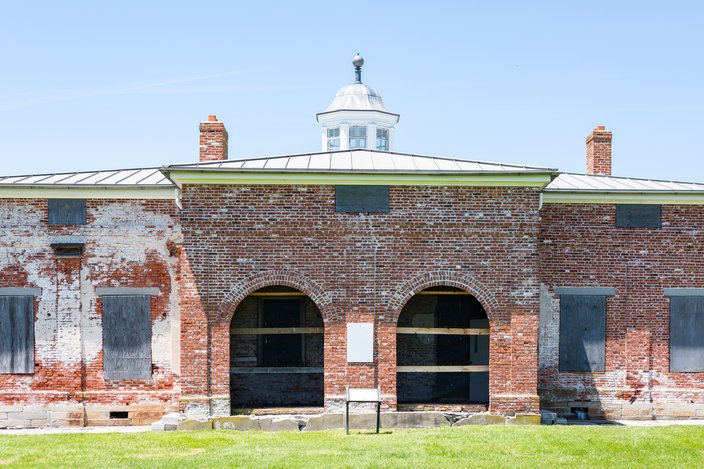
October 19, 2023
 Thom Carroll/for PhillyVoice
Thom Carroll/for PhillyVoice
Fort Mifflin is regarded among the most haunted places in the U.S. The Faceless Man is one of the ghosts purported to inhabit the old base on the Delaware River, which was built before the American Revolution and active until 1950. He is said to be the spirit of Union soldier William H. Howe, the only person executed at the fort during the Civil War.
As William H. Howe climbed the gallows at Fort Mifflin on the afternoon of Aug. 26, 1864, he looked out into a crowd of spectators gathered to watch his execution.
Howe had been a private in the Union army known for his "cheerfulness and alacrity." He was particularly lauded for his bravery at the Battle of Fredericksburg, where he remained on the field after his regiment left. But now his army wanted to make an example of him for deserting and then killing an officer during his apprehension. His execution would be the only public hanging at the Philadelphia fort during the Civil War.
According to reports from the time, Howe died shortly after 12 p.m. "almost without a struggle." His body was then taken from the grounds and returned to his widow. But the legend is the soldier never actually left Philadelphia's famously haunted fort.
Believers claim he is the Faceless Man, an apparition who's appeared in the same cell where Howe was once held and elsewhere on the historical site at Mud Island, a plot of land just south of the mouth the Schuylkill River that once was surrounded by the water of the Delaware River and today is connected to rest of Philadelphia
As the story goes, the ghost's face is missing because a bag was placed over Howe's head before his execution.
"I think he's not at rest because he was made an example of," said Greg O'Brien, a paranormal host at Fort Mifflin. "He was paraded around and I think he was just embarrassed ... I think that's what bothers him and why he still roams the grounds."
O'Brien insists Howe's lingering spirit is neither demonic nor hostile but simply unhappy over his fate. He had good reason to be. Some historians now argue that Howe was unfairly maligned as a deserter and murderer, as he never intended to commit either crime.
When Howe left his regiment behind in Virginia in December 1862, he was suffering from a severe bowel inflammation, the Evening Telegraph reported, and had no access to doctors or medicine. The regimental hospital had burned down, so he and "some twenty others" set out for hospitals in Washington, D.C. Howe, apparently not finding adequate medical attention, kept walking and returned to his home in Montgomery County to recuperate. He was bedridden for months.
While Howe was recovering, desertion became such a concern for the Union that President Abraham Lincoln issued a warning. All soldiers absent without leave could return to their regiments without punishment, apart from forfeited pay, by April 1, 1863. But anyone who did not report by that date would be "arrested as deserters and punished as the law provides."
Howe, according to Fort Mifflin's records of his trial, panicked. In a letter to Lincoln, he explained that he was scared to return. But despite his low profile, authorities located Howe that summer. Three officers then knocked on his door.
After being convicted of desertion and murder, William H. Howe tried to dig out of his cell at Fort Mifflin. He ultimately was sent to Eastern State Penitentiary, where he was held until his execution.
Howe's wife, Hannah, answered but would not let the men in. From here, accounts diverge. The arresting officers claimed Howe shot at them first; Howe said they fired two shots at him as soon as he peered out the window. In either case, Howe opened fire and struck one of the officers, Abraham Bertolet, in the chest, killing him.
As this occurred in the middle of the night, only the Howes and the officers witnessed the skirmish. In testimony, the other two officers painted Howe as the aggressor and even made the outlandish suggestion that "some of the neighbors had offered him five dollars for every Abolitionist he would shoot." (One of those neighbors countered that the officers "seemed to be drunk" in the aftermath of the shooting.) Howe was convicted and sentenced to death by hanging. His lawyer's appeal for a lighter sentence was denied by the president, who generally commuted death sentences from Fort Mifflin.
Before his punishment was handed down, Howe attempted to tunnel out of Fort Mifflin to freedom. But he was caught and placed in solitary confinement in the fort's Casemate 11, an underground bomb shelter that O'Brien describes as "basically a hole in the ground." Howe later was transferred to Eastern State Penitentiary where he remained until his execution. Some 90 troops arrived via tugboat that morning to witness the hanging, according to the Evening Telegraph, and absorb the government's loud and clear message about desertion.
Moments before his death, Howe told onlookers:
"As I have but little to leave my dear children but my record and good name as a soldier, I feel it a duty I owe to them to state now that I never sought the life of the man I killed, and never wished it; and I feel God will pardon me for taking it as I did; and I know my fellow soldiers and officers in the army never blamed me for leaving, as I was an invalid and had no hospital to go to in my regiment. Now that I am about to leave this life I commend my wife and little ones to the charity of the world, and as a last request I ask the pardon of those whom I may have injured, and hope they will forgive me and pray for my soul."
The story is the stuff of ghostly legends, but O'Brien isn't sure that Howe is the Faceless Man. Many soldiers lost their heads to cannonballs during the British siege of Fort Mifflin in 1777, making them likely candidates for the ghost without a face, too. Still, the specter of Howe has shown up in other ways that match his true spirit, believers say.
"We have a tour guide who was in Civil War attire with a big hoop skirt," O'Brien said. "And as she was walking down the stairs to Casemate 11 ... she had an arm help her with her elbow going down the stairs when no one was next to her. So, (I'm) assuming it was William Howe escorting her down."
Follow Kristin & PhillyVoice on Twitter: @kristin_hunt
| @thePhillyVoice
Like us on Facebook: PhillyVoice
Have a news tip? Let us know.
 Thom Carroll/for PhillyVoice
Thom Carroll/for PhillyVoice